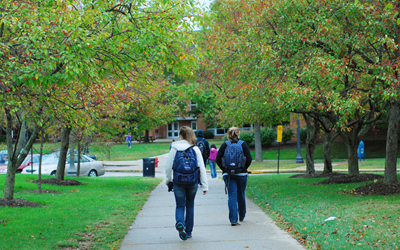Kent State named a Tree Campus USA for third straight year

Photo by Sam Verbulecz
January 27, 2011
Kent State’s trees provide many things for students. They offer shade on a sunny day, give homes to many native bird species and create attractive scenery across campus. Now they are also serving as a continued source of honor for the university.
For the third straight year, The Arbor Day Foundation named Kent State a Tree Campus USA university.
Tree Campus USA is a national program launched in 2008 by the Arbor Day Foundation. It honors colleges and universities who promote urban forestry and environmental stewardship. Kent State was among 29 schools that received the award in 2008, and the first ever Ohio school to be named a Tree Campus USA university.
“I think it’s great that we’ve won again,” said Heather White, manager of Campus Environment and Operations. “I have every intention of keeping (the project) going.”
Other universities to win the award since Kent State include Youngstown State, Ohio Northern University and Kent State Stark.
In order to receive the award, a university must have five things: a campus tree advisory committee, a campus tree care plan, a campus tree program with dedicated annual expenditures, an Arbor Day observance and a service-learning project that engages the students, White said.
“Our goal is to promote and enhance trees on campus and their benefits,” said Jason Knowles, a certified arborist and chairman of the Campus Tree Advisory Committee. “We’ve been pretty happy with the award and what we’ve done so far.”
The committee has attracted faculty members and students dedicated to environmental stewardship.
Brian Vick, the recycling coordinator on campus and a graduate student in business administration, is a member of the committee. Vick has worked to spread awareness about the benefits of trees on campus.
“With proper tree care on campus, with the oxygen they give off and the shade they provide, if trees are aligned in the right positions they can actually give cost savings to the buildings on campus,” Vick said.
Last year for Arbor Day, the committee monitored 10 trees around the Stopher-Johnson area to see the savings that would be amassed over extended periods of time through the life span of the trees. “As time went on, there was an exponential increase, and savings-wise, we’re talking thousands and thousands of dollars,” Vick said
In addition to the special projects Vick mentioned, the committee observes Arbor Day by supporting spring’s Recyclemania — a competition between residence halls on campus to see who can recycle the most within a 10-week period. The winning residence hall receives a tree to plant from the campus tree advisory committee. Last year Stopher-Johnson won the Arbor Day tree for the recycling competition, White said.
In the past, the committee completed its service-learning requirement for the Tree Campus USA award by giving trees and shrubs to volunteers from the Department of Biological Sciences to improve the health of the stream near the Student Recreation and Wellness Center.
The current service-learning project the committee has undertaken is working with Oscar Valverde-Barrantes, a graduate ecology student, to establish an interactive tree walk across campus. The tree walk will provide an explanation of a tree’s species and cultural significance, if any, to campus, White said.
“I think we all take a sense of pride (in winning the award again),” Knowles said. “This is just another step of promoting trees and their overall value.”
Contact Julie Sickel at [email protected].











